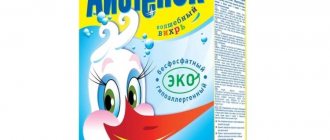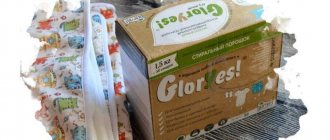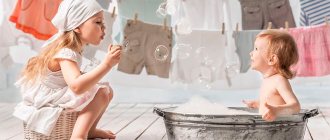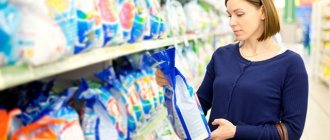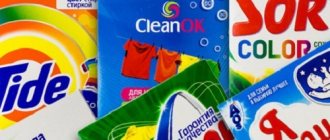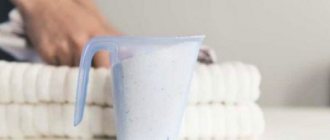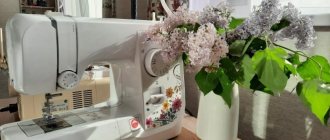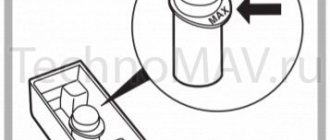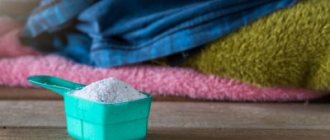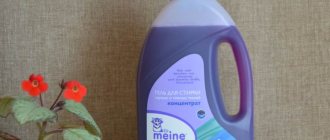Updated: 03/07/2021 15:48:28
Expert: Orlova Svetlana Anatolyevna
*Review of the best according to the editors of expertology.ru. About the selection criteria. This material is subjective in nature, does not constitute advertising and does not serve as a purchase guide. Before purchasing, consultation with a specialist is required.
A newborn baby requires special care and careful care. The correct choice of household chemicals and hygiene products guarantees the protection of a fragile body and the preservation of its health for many years. Doctors recommend using special washing powders for children from the first day of life. Conventional products contain components that are harmful to baby's skin. As a result, he may experience allergic rashes, decreased immunity, and metabolic disorders.
To avoid this, Expertology experts have compiled a rating of the best baby powders, based on the opinions of dermatologists and reviews of mothers. So, let's figure out what substances should not be in baby powder at all.
- Phosphates. Reduce immunity and protective functions of the body.
- Chlorine. Causes severe allergic reactions, a very toxic substance.
- Optical brightener. Unlike oxygen, it does not rinse well and causes unpleasant rashes and redness.
- Surfactants (surfactants). Exceeding the maximum permissible norm can cause various diseases and developmental delays.
- Fragrances. Their pungent odor also negatively affects the baby's health.
The most optimal are washing powders based on soap and plant extracts. They do not have a negative effect on the baby's delicate skin. Many natural substances included in the composition have anti-inflammatory, wound-healing and bactericidal properties.
What is the difference between baby powder and regular powder?
It is impossible to distinguish between products for children's clothes and ordinary clothes by external signs.
Most powders are not completely washed out of the fabric after washing, even after 3-4 rinses. Residues of hazardous substances penetrate the child’s body through the skin and can cause allergic reactions or even poisoning.
The main difference between products for children and adults is the level of toxicity. It can only be tested in laboratory conditions using living cells.
In everyday life, washing powders for children and adults can be distinguished only by indirect signs. Thus, washing powder labeled “children’s” or “for children’s underwear” contains a lower concentration of surfactants (surfactants) compared to regular detergents. It is this component that causes irritation on the skin, remaining in the tissue structure for at least 3–4 days.
In an “adult” product, unlike a good children’s product, additives are additionally used for:
- color preservation
- imparting softness to fabrics
- removing tough stains
- easy ironing
- giving a pleasant aroma
How to wash clothes for newborns in a washing machine
Infants' underwear should be machine washed separately from other items. Adults' clothes are characterized by microflora and bacteria, so they cannot be washed together with children's clothes. This can cause infections and illnesses. After washing, you need to store clothes in a separate box, after ironing them first.
At what temperature should I wash?
Natural cotton fabrics can be washed at temperatures up to 90 degrees. This is the optimal mode for white items made of thick material. Colored undershirts and rompers will become discolored during high-grade processing. For such fabrics, a mode at 40 degrees is suitable. Delicate materials such as silk and wool are best processed at 30 degrees to prevent fabric shrinkage.
What mode should I wash on?
The clothing manufacturer leaves care instructions on the tag. Pay attention to the temperature conditions indicated there. The label also indicates whether a spin can be used.
Most machines are equipped with a “Hypoallergenic wash” mode. Use it to clean baby items. If this mode is not provided by the model, use an additional rinse. This will remove any remaining powder completely.
Requirements for a reliable washing powder
A reliable baby wash product should not contain preservatives or fragrances.
A reliable and safe detergent for washing children's clothes must meet the following criteria:
- Contain as few components as possible. Additional additives have a negative effect on the skin and health of children
- Be hypoallergenic. Such products are produced with the marks “For newborns” or “From the first days of life”
- Does not contain fragrances. Their presence in the composition is easy to recognize by their persistent “chemical” smell.
- Have a short shelf life. Optimally – 1–3 years, if more, then the composition contains potentially dangerous preservatives
- Contain zeolites or sodium disilicate instead of unsafe phosphates
- Contain oxygen bleaching agents such as sodium percarbonate
- Include soft enzymes that successfully cope with protein or fatty contaminations
- To be completely washed out of any type of fabric as quickly as possible (ideally in one wash)
Optical brighteners are ultraviolet dyes that only create the appearance of whiteness, but do not affect the structure of the fabric.
The category of important, but not critical, factors when choosing a powder includes:
- economical (children's clothes are washed almost daily)
- effectiveness (the product should remove dried stains and stubborn stains from fruit and vegetable purees)
- softness of linen (important for delicate baby skin)
What components should not be in baby powder?
Powder with phosphates will soften water, but will have a negative effect on the child’s body
The following components of laundry products are considered potentially dangerous to a child’s health, well-being and immunity:
- Phosphates (phosphonates and phosphorites) - elements prevent the formation of scale on the elements of the washing machine, soften hard tap water. At the same time, they cause allergic reactions upon contact with the skin and reduce the body’s protective functions.
- Optical brighteners - do not wash out of fabrics even after repeated rinsing
- Chlorine _ Toxic substance that will inevitably cause allergies on children's skin
- Anionic surfactants (A-tensides). Even after the third rinse, up to 10 mg/l of these dangerous components remain in the water
The listed elements are poorly washed out of the fabric structure and can lead to the occurrence of:
- allergic dermatitis
- metabolic disorders in the cells and tissues of the body
- dysfunctions in the liver and kidneys
How to wash clothes for newborns before the maternity hospital
New clothes look attractive and keep their shape thanks to the starch and other means with which they are processed. Before you put new clothes on your baby, you need to wash them.
You can prepare things for a baby in the maternity hospital in several stages:
- Remove tags and remove labels. Be careful not to damage the fabric.
- Soak the items in a bowl of warm water for a short time and rinse by hand. You can use special tools.
- Change the water several times when rinsing.
In an automatic machine, you need to wash clothes for a newborn as follows:
- Place items without labels in the drum separately from other clothes.
- Select short wash cycle. Set the temperature to 40 degrees.
- Use the extra rinse function.
After cleaning, shake and dry items on the line. Iron from the wrong side and carefully fold the diapers and vests into a pre-prepared place.
The best foreign products
Based on the composition of the products, expert recommendations and reviews of people who have been using them for a long time, the following rating of reliable foreign powders for baby laundry has been created:
1
Burti Hygiene (Germany)
Contains soap base and brighteners, does not contain phosphates. Hypoallergenic, economical, has a disinfecting effect. It is better to use for white and light-colored laundry, as colored clothes can bleach strongly. The cost of a pack weighing 1.1 kg is about 1 thousand rubles
Burti Hygiene
2
Tide children's (USA)
Contains extracts of chamomile and medicinal plant aloe. Suitable for sensitive skin, but it is better not to use the product for newborns. An economical package weighing 3 kg will cost 300–400 rubles
Tide for children
3
Babyline (Germany)
One of the best ingredients: oxygen bleach and soap base. Removes most stains even in cold water, does not cause reactions on the skin, and is used sparingly
The German product Babyline does not contain potentially hazardous components
4
Meine Liebe (Germany)
Does not contain phosphates, chlorine or fragrances. Shows good results when washed in cold water, copes with difficult stains on white and colored children's clothing. Dermatologist approved and wears off slowly even with frequent use
Meine Liebe
5
BioMio (Denmark)
Liquid laundry detergent with a natural, safe composition. Suitable for children's underwear, newborns and delicate fabrics of adult clothing. Can be used for hand washing, economical due to high concentration
BioMio
6
Amway (USA)
Effectively removes stains using natural enzymes. Can be rinsed out of fabric in 1 wash cycle, safe and hypoallergenic. The silicic acid salts in the composition prevent the formation of scale on the elements of the washing machine.
Amway
Domestic products that have earned trust
Russian manufacturers provide a large selection of products for delicate washing of linen and children's clothing with safe composition and low price.
Most popular products:
1
Eared nanny (“Nevskaya cosmetics”)
Despite the presence of phosphates in the composition, it is suitable for washing clothes of those children who do not suffer from allergies. Non-volatile, washes well and removes even stubborn stains from cereals, juices and fruit purees. The product is more affordable than other products (300 rubles for 2.5 kg)
Eared nanny is one of the most popular laundry detergents with good reviews
2
stork
The powder is perfect for children with allergies, as it does not contain phosphates or aggressive substances, and is suitable for hand washing (contains aloe vera extract). Without a strong odor, softens fabrics and easily dissolves in water. The only drawback is that it can only cope with light stains. A half-kilogram pack will cost 50 rubles
stork
3
Tobbi Kids (Sterlitamak)
Soap-based baby laundry detergent with the addition of soda and mild surfactants. It has the appearance of a white powder with colored granules without a distinct odor. Whitens the fabric, but does not remove old, dried stains. A standard pack of 2.5 kg costs about 350 rubles
Tobbi Kids
4
Umka (Nizhny Novgorod)
Natural soap-based powder with nonionic surfactants in its composition. Cope with stains even in cold water, hypoallergenic. Can be used both for machine washing and hand cleaning, gives fabrics softness
Umka
5
Chistown
Powder for children's clothing based on soap, soda and citric acid. Removes stains efficiently and is odorless and colorless. Easy to wash, can also be used for hand washing. Cost: from 100 rub. for 0.5 kg
Chistown
Products with natural composition
The absence of synthetic components in the composition is the main advantage of baby powder. The most reliable organic detergents:
1
Pure Water
The product is made in Russia. The main active ingredient is sodium salts of coconut oil. The product contains less than 15% baking soda, less than 5% sodium percarbonate, silicate and sodium citrate. Suitable for washing regular items. The cost of a package weighing 1 kg is 390 rubles
Pure Water
2
our mother
Russian-made children's soap powder is made from soap shavings, which interact most gently with fabrics and skin. Contains tallowate, cocoate and sodium palmitate (coconut and palm oils), glycerin, water and titanium dioxide. The product is easy to rinse out. A pack weighing 0.5 kg costs from 200 rubles
Baby wash products tend to be more expensive than their surfactant- and phosphate-rich counterparts
3
Sodasan
The product for sensitive skin, which can be used for colored and white laundry, is produced in Germany. The product is based on organic soap made from vegetable oil. The components also include: soda, silicate, iminodisuccinate, citrate and polyaspartate
Sodasan
4
Garden Kids
An environmentally friendly concentrated product with silver ions, which provide an additional disinfectant effect. 30% of the product consists of natural baby soap. Washing efficiency is ensured by baking soda and sodium citrate. The cost of a 1.35 kg package is from 400 rubles
Garden Kids
5
Molecola
Palm and coconut oils in the base of the product ensure gentle removal of stains on white and colored children's underwear. The powder contains plant enzymes. The cost of a pack of 1.2 kg is 370 rubles
Molecola
Criterias of choice
The products are packaged in boxes, plastic bags, and bottles. The responsible manufacturer provides detailed information on the packaging:
- compound;
- appointment;
- consumption rates;
- precautionary measures.
Child's age
Contamination of the laundry of newborn children is organic in nature. Powdered products made from soap and soda can handle them without any problems.
Budget
In order to save money, young families are better off choosing Russian-made detergents with herbal ingredients. It is profitable to buy expensive concentrated gels (powders), they have a small consumption rate.
Safety
Before choosing a powder, you need to evaluate the presence and percentage of harmful substances (chlorine, phosphates, tensides). Do not harm babies:
- Non-ionic surfactants;
- Natural surfactants;
- herbal supplements in the form of oils, herbal extracts.
Hypoallergenic
The box (bottle) must be marked “hypoallergenic”.
Packaging tightness
In unsealed packaging, the powder becomes damp and loses its properties.
Manufacturer reputation
To identify popular manufacturers, surveys are conducted among consumers. Based on them, the most popular brands are determined. Russian housewives are more likely to purchase baby detergents;
Delicacy of care
The labeling must contain information about the purpose of the product: type of washing machine (automatic, semi-automatic), type of material, washing method.
Popular products that you shouldn't trust
Despite their popularity and good reviews, it is better not to purchase some products for washing children's clothes due to the presence of dangerous components.
Examples of such washing powders:
1
Children's myth
Contains surfactants, enzymes, optical brighteners, fragrances. Has a strong odor and does not remove greasy stains well
Children's myth
2
Karapuz
Contrary to the assurances of the manufacturers, the product causes allergic dermatitis. In addition, the product is difficult to wash out of fabrics and is volatile – it settles on the mucous membranes of the respiratory system.
Karapuz
3
Free Time Children
Contains: anionic surfactants, optical brighteners, enzymes and flavoring additive. Colored granules in powder leave streaks and are not washed out
Free Time Children
4
Spring tenderness
Contains phosphates, does not remove stains, forms a lot of foam, is difficult to wash out of fabric
Phosphates in first place among the components in the composition should alert the consumer: such a product is not suitable for children
Signs of allergies
When using a new detergent, the mother should monitor the condition of the newborn. Any manifestation of allergies is dangerous. It is urgent to stop using the powder (gel).
Dry and flaky skin
The baby's skin is covered with small dry scales.
Rash, redness, itching
Red rashes in the area of skin folds on the arms, legs, groin, and buttocks. The child is bothered by itching.
The appearance of wet blisters on the body
When the baby's skin comes into contact with poorly rinsed fabric, bubbles with a diameter of 1-2 mm filled with liquid form on the neck, arms, buttocks and skin of the legs.
Red, droopy eyelids, watery eyes
A newborn develops allergic conjunctivitis. It manifests itself as redness, photophobia, itching, and lacrimation.
Sneezing
The pungent smell of washed diapers and baby vests irritates the nasal mucosa, causing the baby to sneeze.
Cough, nasal congestion, swelling
Fragrances cause inflammation of the mucous membranes of the nose and throat . The baby's body reacts to irritation by coughing.
Eczema, purulent inflammation
Phosphorus salts and bleaching agents cause contact dermatitis and eczema.
Conclusion
Everything that touches a child’s skin should be as safe as possible – this postulate also applies to washing powder. The decisive criteria when purchasing a laundry detergent: safety and effectiveness. Additional characteristics include economical composition and low price.
The video shows how to choose safe baby washing powder:
VIDEO: Children's washing powders. Which one washes better?
TOP 20 Best children's washing powders: review and recommendations for selection + Reviews
Recommendations for choosing a detergent are given in the story:
